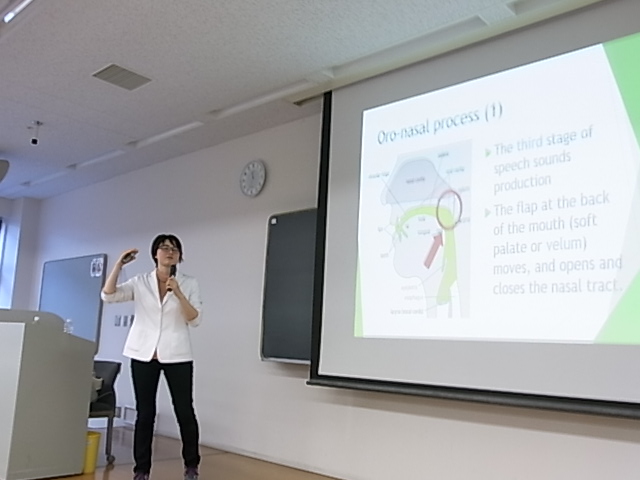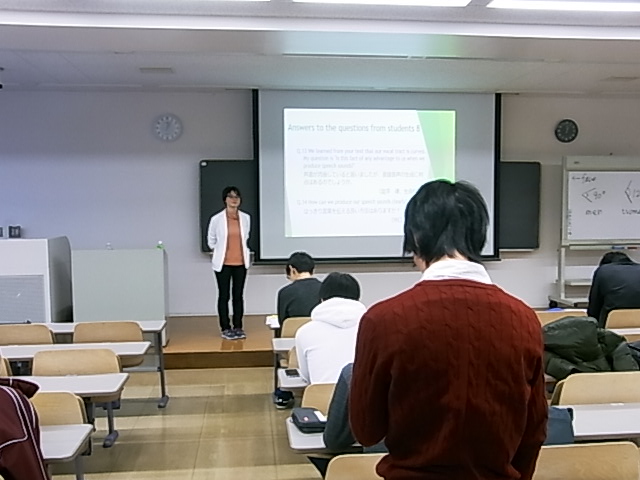ミニ講演会-共通科目コース-
「How Do Humans Communicate with Speech Sounds?」 イベント
第17回理工学部、建築・環境学部教養学会主催「理系学生のための英語公開ミニ講演会」
(English Lecture Meetings for Science-Major Students)
How Do Humans Communicate with Speech Sounds?:
Mechanism of Human Voice Production
(人はどのように音声でコミュニケーションをするのか~人の発声メカニズム~)
講師:関東学院大学文学博士、非常勤講師、大沢記念建築設備工学研究所研究員 本沢 彩 先生
言語には書き言葉、話し言葉があり二つの種類がある。話し言葉には様々な形態があるが、すべての音声が話し言葉ではなく、あくびの音や「痛い!」などの発生は意思伝達のためではないので言語音声ではなく、意思伝達のための音のみが話し言葉と見做される。そして言語音声を作りだす発話プロセスは以下のように大別することが出来る。1.肺からの呼吸器系において起こる気流プロセス、2.喉で起こる発声プロセス、3.鼻腔、口腔プロセス、4.口腔内で起こる調音プロセス。
気流プロセスにおいては肺からの空気が我々の言語音の源となっている。話し言葉の生成においては喉頭が大きな役割を担っている。
人の肺にはおよそペットボトル7本分程度の空気が蓄えられ、呼吸においては500ccほどの空気の入れ替えが行われる。講師は、どのくらいの量の空気を排出できるかが、私たちの言語音声の生成の能力に深くかかわることを聴講者全員で風船を膨らましながら試した。発声プロセスにおいて、肺からの空気は喉頭の声帯を通り、振動をおこして音声を作りだす。講師は骨、軟骨、筋肉などから成る複雑な喉頭の構造と音声発声に重要な役割を担うその中心部の声帯と声門の開閉の仕組みを図によって説明された後、実際に声帯で生成される音声を再生、紹介した。また、発声プロセスにおいて肺からの空気を音声に変換する能力の差を聴講者全員による発声の実験によって示された。喉頭において生成された音声は口腔と鼻腔からなる声道へと移動する。軟口蓋の口蓋垂が下がると鼻腔への空気の流れが開放され、口蓋垂が上がると鼻腔への空気の流れが閉鎖されることが説明された。最後の調音プロセスにおいては舌、唇、あごのような口腔内の部位の動きにより作り出される口腔の形が言語音声の質の変化をもたらすことが説明された。
このモデルを考案したのはスウェーデンのエンジニアであり科学者である、グンナー・ファントであり、共鳴現象に基づくこのモデルは1960年に提唱され、線形音源フィルタ理論と呼ばれる。
共鳴においては強調される周波数成分、ピッチ要素が明瞭に聞きとられる。グンナー・ファントら音声科学者は声道をその中で共鳴が起こる閉管と考えた。/i/,/u/,/a/のような異なる音は各々異なった形の声道内の共鳴によって生成される。
共鳴において強調される周波数はフォルマントと呼ばれる。フォルマントは声道の形によって異なるので、声道の形が音声の質を変えることになる。母音の音の決定には第一フォルマントと第二フォルマントが重要であり、それらは舌の位置により変化する。例えば、最も高い位置が前部の高い位置にあると/i/の音となり、最も高い位置が後ろにあり中間の高さにあると/o/の音となる。
即ち、言語音声の発生には呼吸器系の能力、発声能力、そしてのど、口、鼻の中の声道での正しい共鳴が起こるための正しい調音能力が必要である。
当日聴講者より以下のような質問に対し、講師は(1)人間の体の大きさによって声の性質がかわること、(2)喉頭や声帯の大きさの違いにより声帯の振動周波数が変わり(女性は増加)声の高さの違いが生じること、(3)性ホルモンが体を大きくする過程において女性にも(喉頭が大きくなることによる)声変わりは起きているが、男性の場合においては体の大きさに応じて大きな変化が起こるので、声変わりの結果も目立つこと、(4)喉頭の一部である「喉ぼとけ」が男性の方が女性よりも大きいと一般に考えられているが、実際は男女で喉ぼとけを形作る軟骨の形が異なり、男女間で声の高さが異なること(5)声帯のポリープ、かゆみを伴う炎症や他の病気により声帯が振動しにくくなることや、声道内の痛みや炎症等により共鳴が起こりにくくなる特定の部位を大きくすることなどの要因が、「声が枯れる」という現象を生じさせること、(6)風邪をひいて鼻が詰まっていたり、声帯が十分機能していないと気流エネルギーを効率的に音声に変換できなくなり、声道内の共鳴効果が十分でなくなるため音声が不明瞭になること、(7)鼻が詰まっていると発声がしにくいのは空気の量が問題なだけではなく、音声に変換される空気の量の減少が問題であること、(8)声道における明確な共鳴が起こるためには鼻腔と口腔の両方が必要であること、(9)もし声道がとても短ければ音声は十分な共鳴を得られないので、「ほえ声」のようになるのではないかと考えられること、(10)声道の形状を変えずに異なった音声を生成することはできず、一つの声道の形では一つの音声しか生成できないことなどを説明された。
(当日の聴講者よりの質問)
Q. Why are the voices different from person to person?
Q. Why are the pitch of voices different between men and women?
Q. Why does the change of voice happen to only boys, not girls?
Q. Why does an adult male have an Adam’s apple? Does it have any phonetic effects?
Q. What happens to human organs when a person’s voice changes?
Q. When our voice become hoarse, what happens to our vocal cords?
Q. Why can’t we pronounce clearly when our nose is stuffed?: Is the air coming from the lung not enough?
Q. Are both an oral tract and a nasal tract needed for the articulatory process to occur?
Q. What kind of speech sound will we make if our vocal tracts were very short?
Q. I understand that articulation is producing sounds by changing the shapes of our speech organs. My question is “Is it possible to produce sounds without changing the shapes of our speech organs?”
Q. Your text says that movement of parts of the oral tract such as the tongue, the lips and the jaw change the shape of the oral tract, but how do they change it?
Q. Why can we idealize our curved vocal tract and regard it as a straight pipe?; in other words, does it produce the same sounds whether it is curved or straight?
Q. Are the frequencies of the human voices different from those of the voices of other animals?
Q. How are ventriloquists like Ikkokudo producing speech sounds?
Q. I think that monkeys have a respiratory system like that of humans.
My question is “Can monkeys also produce speech sounds?”
Q. How can we produce our speech sounds clearly?
Q. The text explains that when the speech sounds are emitted from the lips, the frequency component is emphasized 8 dB per octave? Could you explain why?
Q. Do the shapes of our lips change the quality of our speech sounds?
Q. Why are the qualities of voices different when we sing from when we talk?
Q. What’s happening when a person produces a falsetto by accident?
Q. Our voices become high-pitched if we speak after inhaling helium gas. Do our voices change if we speak in high mountains where the air is thin?
Q. We learned from your text that our vocal tract is curved. My question is “Is this fact of any advantage to us when we produce speech sounds?”
(2017年12月18日開催)

